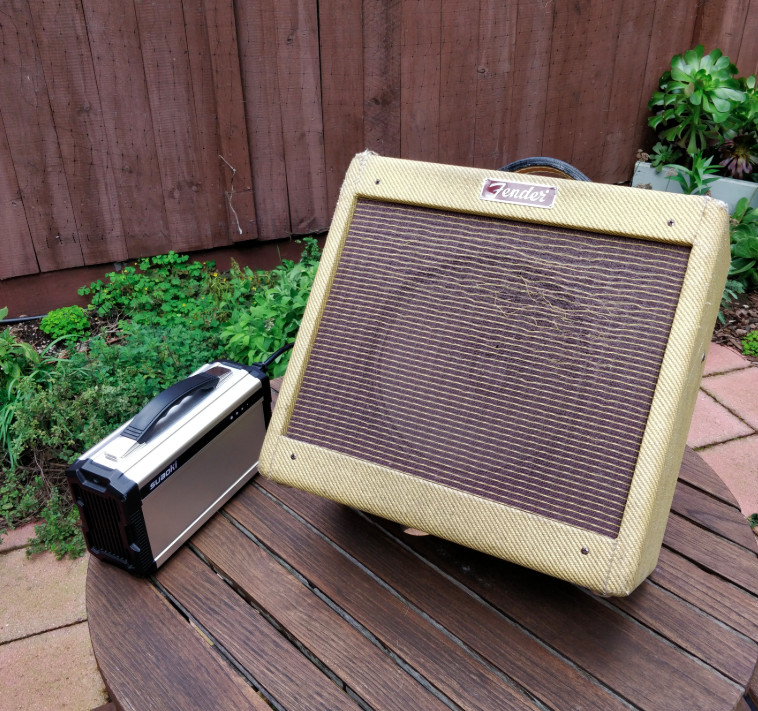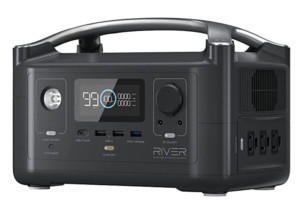The question of finding the “best Battery Powered Guitar Amplifier” is a common one among guitarists seeking portability. It’s a query that often pops up in online forums and gear discussions, echoing the desire for musical freedom untethered by power outlets.
 Fender Pro Jr. tube amp powered by a lunchbox-sized battery
Fender Pro Jr. tube amp powered by a lunchbox-sized battery
However, like many technical inquiries, the initial question might be framing the problem incorrectly. My experience, drawing parallels from my past in software engineering, has taught me that asking the right question is crucial to finding the best solution. In software, diving into specific code issues before understanding the broader problem often leads to inefficient solutions. Similarly, in the realm of guitar amplification, directly searching for a “battery powered guitar amp” might limit our options and overlook more versatile and powerful alternatives.
Imagine this scenario: you’re booked to play an intimate outdoor gig – perhaps a wedding ceremony in a picturesque location without readily available power. You need your guitar amplified, but traditional mains power is out of reach. The immediate thought might be, “I need a battery powered guitar amplifier.” But let’s reframe that. The core issue isn’t the type of amplifier, but rather: “How can I power any amplifier when there’s no wall outlet available?”
This shift in perspective opens up a world of possibilities beyond the limitations of solely battery-powered amplifiers. Thanks to advancements in lithium battery technology, the same technology powering electric vehicles and smartphones, we now have access to portable power stations. These compact units, often no larger than a lunchbox, can supply standard AC power, effectively bringing the wall outlet with you.
These portable power stations, typically marketed for camping, emergency preparedness, or outdoor work, are readily available from numerous brands on platforms like Amazon. After testing various options, I’ve found models like this one from Ecoflow to be particularly effective.
 Ecoflow portable power station with multiple ports
Ecoflow portable power station with multiple ports
These devices offer rapid charging capabilities (often under two hours), multiple USB ports for charging other devices, and crucially, standard AC outlets. A model like the one mentioned boasts 288-watt hours of capacity. The implications for guitarists are significant. A 60-watt amplifier, for instance, theoretically could run for almost five hours (288 watt-hours / 60 watts = 4.8 hours). However, in real-world scenarios, the runtime is often much longer. Amplifiers rarely operate at their maximum rated wattage continuously, especially in typical performance situations where full volume isn’t always necessary or desirable.
In my own experience, I’ve reliably powered my AER Alpha acoustic amplifier for multiple 2-3 hour gigs on a single charge of a power station. I’ve even used it with more power-hungry 15-watt tube amplifiers like my Fender Princeton Reverb. The versatility extends further; I’ve connected power strips to run multiple devices simultaneously and even lent it to a fellow musician who successfully powered a QSC K10 PA speaker.
One minor consideration is potential noise interference from the power station’s inverter. Positioning the power station a few feet away from the amplifier usually resolves this. Additionally, guitars with single-coil pickups might exhibit slightly increased hum, particularly when not touching the strings, as the grounding situation differs from a traditional grounded mains outlet. Solutions to minimize hum in such scenarios are welcome and still being explored.
Update on Noise and Power Quality: Further experimentation has revealed that newer power station models, like this Ecoflow model, have significantly improved noise management and power delivery. The pure sine wave output of these units minimizes added hum, even with sensitive pickups like my Dearmond FHC. This improvement in power quality makes them even more suitable for powering sensitive audio equipment.
Important Safety Note Regarding Tube Amplifiers: A reader raised a crucial point regarding safety, especially when using tube amplifiers outdoors with portable power stations: “I would never risk running a tube amp off of one of these power supplies outside. Without a proper ground you’re taking a daring step. Tube amps run very high voltage internally with current levels in the ‘no return zone’ meaning, getting zapped while playing in the outdoors could be that final gig.” This is a valid concern. While I have used tube amps with power stations, I primarily use solid-state amplifiers now for battery-powered gigs for increased safety and battery efficiency. Tube amps, by their nature, consume significantly more power than solid-state amps, leading to shorter runtimes.
When Dedicated Battery Powered Amps Still Fit: Despite the versatility of power stations, dedicated battery-powered amplifiers still hold a valuable place, particularly for ultimate convenience and portability. Roland’s CUBE series amplifiers are excellent examples. Their ability to run for extended periods on readily available AA batteries is truly impressive, offering a straightforward, grab-and-go solution. Conversely, amplifiers relying on heavy, proprietary sealed lead-acid batteries can be less practical. If you forget to charge them, you’re out of luck, whereas AA batteries are easily replaceable in almost any situation.
In Conclusion: While the initial question of “which battery powered guitar amplifier” is understandable, broadening our perspective to consider portable power stations unlocks a much wider range of amplification possibilities. Power stations allow you to power virtually any amplifier, offering flexibility and potentially superior tone compared to smaller, dedicated battery amps. However, for ultimate grab-and-go simplicity and situations where lightweight portability is paramount, dedicated battery amps like the Roland CUBE series remain excellent choices. The key is to understand your specific needs and choose the power solution that best fits your musical journey, wherever it may take you – even if it’s hypothetically on a raft in a frog pond.
